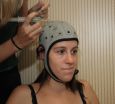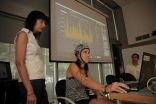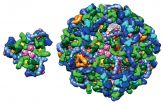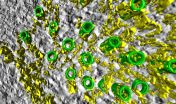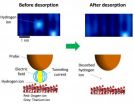Neuroscience and technology come together to support people with disabilities
The Centre for Genomic Regulation, Starlab and the University of Barcelona presented this morning Brain Polyphony, an interdisciplinary project that aims to improve communication for people with disabilities
2015-07-10
(Press-News.org) This news release is available in Spanish.
Scientists at the Centre for Genomic Regulation (CRG), the research company Starlab and the group BR::AC (Barcelona Research Art & Creation) of the University of Barcelona developed a device that produces sounds from brain signals. This highly interdisciplinary team is led by Mara Dierssen, head of the Cellular & Systems Neurobiology group at CRG. Its ultimate goal is to develop an alternative communication system for people with cerebral palsy to allow them to communicate--and more specifically in this pilot phase, to communicate their emotions. Scientists are carrying out the project with volunteers who are either healthy or who have physical and/or mental disabilities, working together with the association Pro-Personas con Discapacidades Físicas y Psíquicas (ASDI) from Sant Cugat del Vallès.
"At the neuroscientific level, our challenge with Brain Polyphony is to be able to correctly identify the EEG signals--that is, the brain activity--that correspond to certain emotions. The idea is to translate this activity into sound and then to use this system to allow people with disabilities to communicate with the people around them. This alternative communication system based on sonification could be useful not only for patient rehabilitation but also for additional applications, such as diagnosis," stated Mara Dierssen. She added, "Of course, the technological and computational aspects are also challenging. We have to ensure that both the device and the software that translates the signals can give us robust and reproducible signals, so that we can provide this communication system to any patient."
Currently, other signal transduction systems (using brain-computer interfaces) are undergoing testing for people with disabilities. However, most of these systems require a certain level of motor control, for example, by using eye movement. This represents a major constraint for people with cerebral palsy, who often suffer from spasticity or who are unable to control any aspect of their motor system, making it impossible for them to use these systems. A further limitation is that most of these other devices do not allow real-time analysis of the signals but rather require information post-processing. The proposal put forth by the Brain Polyphony researchers now allows real-time analysis, starting from the moment the user puts on the interface device.
The sound of our brain
Unlike other existing sonification systems using brain signals, Brain Polyphony allows us to directly "hear" brainwaves. "For the first time, we are using the actual sounds of brain waves. We assign octaves (as they are amplified) until we reach the range audible to the human ear, so that what we hear is really what is happening in our brain. The project aims to achieve this sound and to identify a recognizable pattern for each emotion that we can translate into code words. And all of this happens instantaneously in real-time," explained David Ibáñez, researcher and project manager of Starlab.
Until now, the device has been tested mainly with healthy people, but the most recent tests with people with disabilities have been pleasantly surprising. The device was also presented at the 2015 Sónar festival in Barcelona, where it enhanced the artistic expression of the event by allowing users to "hear" the music created by their emotions. Along this line, Efraín Foglia, researcher at BR::AC, University of Barcelona, added: "The mere fact that we are able to hear our brains "talk" is a complex and interesting experience. With Brain Polyphony, we are able to hear the music that is broadcast directly from the brain. This is a new form of communication that will take on a unique dimension if it can also allow us to enable people with cerebral palsy to communicate."
Bringing science to market, a challenge for research centres
This project not only exemplifies the importance of collaborations between scientific disciplines but also provides a success story in how to bring basic research to society. Brain Polyphony was the result of an internal initiative of the Center for Genomic Regulation (CRG), which seeks to promote multidisciplinary approaches and mainstreaming of basic research focused on patients and society, especially at an early stage. "We encourage our researchers at CRG to propose translational and collaborative projects that should involve clinics or other companies in the health sector groups. For that, we created an internal call to grant additional seed funding, to allow them to do risky and innovative projects and ideas. The idea is to encourage them to try an initial project that they can then use after a year to make the leap to applying for more ambitious and competitive funding. Brain Polyphony shows how important institutional support, like the CRG commitment, can be to such projects", concluded Michela Bertero, responsible for the Scientific and International Affairs office at CRG.
INFORMATION:
ELSE PRESS RELEASES FROM THIS DATE:
2015-07-10
The great white shark (Carcharodon carcharias) has a terrifying reputation. Shark attacks, though very rare, loom large in our imaginations, drawing intense media attention when they occur. Recent injuries in North Carolina are putting sharks in the limelight again. But going after sharks à la Jaws is not the best way to protect people in the water, said shark researchers.
California scientists found that the risk of white shark attack for individual ocean users in California has fallen strikingly, by over 91 percent, since 1950, in a study to be published online ...
2015-07-10
Many areas of fundamental research are interested in graphene owing to its exceptional characteristics. It is made of one layer of carbon atoms, which makes it light and sturdy, and it is an excellent thermal and electrical conductor. Its unique features make it potentially suitable for applications in a number of areas . Scientists at EPFL's Bionanophotonic Systems Laboratory (BIOS) together with researchers from ICFO- The Institute of Photonic Sciences in Barcelona, have now harnessed graphene's unique optical and electronic properties to develop a reconfigurable highly ...
2015-07-10
Men may feel threatened by female supervisors and act more assertively toward them than male bosses, which could disrupt the workplace with struggles over power dynamics, according to new research published by the Society for Personality and Social Psychology.
"The concept of masculinity is becoming more elusive in society as gender roles blur, with more women taking management positions and becoming the major breadwinners for their families," said lead researcher Ekaterina Netchaeva, an assistant professor of management and technology at Bocconi University in Milan, ...
2015-07-10
Heidelberg, 10 July 2015 - Researchers at EMBL Heidelberg have produced detailed images of the intricate protein-coats that surround trafficking vesicles - the "transport pods" that move material around within biological cells. The study, published today in Science, provides a new understanding of the complex machines that make up the cells' logistics network.
Vesicles are responsible for transporting molecules between the different compartments within a cell and also for bringing material into cells from outside. There are several types of vesicle: each has a specific ...
2015-07-10
University of Warwick researchers have discovered a cell structure which could help scientists understand why some cancers develop.
For the first time a structure called 'the mesh' has been identified which helps to hold together cells. This discovery, which has been published in the online journal eLife, changes our understanding of the cell's internal scaffolding.
This also has implications for researchers' understanding of cancer cells as the mesh is partly made of a protein which is found to change in certain cancers, such as those of the breast and bladder.
The ...
2015-07-10
Treating obese pregnant women with a diabetes drug does not stop their babies from being born overweight, a study has found.
Doctors had hoped that the treatment would help to reduce obesity rates and lower the number of difficult births.
Heavier babies are more likely to grow into overweight adults. They also have a higher risk of illnesses later in life, such as diabetes and heart disease.
It is thought that the additional weight gain in the womb is caused by exposure to excess blood sugar.
Researchers tested whether treating overweight mothers-to-be with the ...
2015-07-10
A research team comprising scientists from Tohoku University, RIKEN, the University of Tokyo, Chiba University and University College London have discovered a new chemical reaction pathway on titanium dioxide (TiO2), an important photocatalytic material.
The reaction mechanism, reported in ACS Nano, involves the application of an electric field that narrows the width of the reaction barrier, thereby allowing hydrogen atoms to tunnel away from the surface. This opens the way for the manipulation of the atomic-scale transport channels of hydrogen, which could be important ...
2015-07-10
(BOSTON) - Traditional robots are made of components and rigid materials like you might see on an automotive assembly line - metal and hydraulic parts, harshly rigid, and extremely strong. But away from the assembly line, for robots to harmoniously assist humans in close-range tasks scientists are designing new classes of soft-bodied robots. Yet one of the challenges is integrating soft materials with requisite rigid components that power and control the robot's body. At the interface of these materials, stresses concentrate and structural integrity can be compromised, ...
2015-07-10
The middle classes from developing countries are more susceptible than western Caucasians to obesity, type 2 diabetes and cardiovascular disease in today's changing environment. New research published today in Cell Metabolism from the University of Sydney in Australia, the National Centre for Cell Science and the DYP Medical College in Pune, India reveals this may be a result of the nutrition endured by their ancestors.
The findings in the paper titled Multigenerational Undernutrition and Diabetes could explain projections that more than 70 per cent of the global burden ...
2015-07-10
ORLANDO, FL - While multidirectional instability of the shoulder (MDI) has been traditionally treated without surgery, research presented today at the American Orthopaedic Society for Sports Medicine's (AOSSM) Annual Meeting in Orlando, FL, shows surgery is also effective for this type of dislocation.
"We examined 41 athletes who received arthroscopic surgery for MDI, and noted 73% returned to play at equal or only slightly lower level than before the injury," commented M. Brett Raynor, MD, lead author from Steadman Philippon Research Institute Program. "Our study group ...
LAST 30 PRESS RELEASES:
[Press-News.org] Neuroscience and technology come together to support people with disabilities
The Centre for Genomic Regulation, Starlab and the University of Barcelona presented this morning Brain Polyphony, an interdisciplinary project that aims to improve communication for people with disabilities
